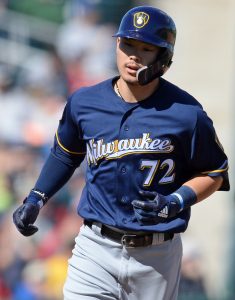If and when the baseball season resumes in 2020, it’s expected to do so with the oft-debated universal DH implemented. With than in mind, we’re running through each NL team’s DH options . Today, we’re looking at the innovative Milwaukee Brewers, who’ve demonstrated their willingness to get creative with personnel under manager Craig Counsell.
Counsell’s club looks pretty well-positioned to adapt to the rule change, though it seems like they won’t need to rely on just a single player to handle the DH duties; rather, they’ve got a host of capable players at their disposal, and should be able to adjust their lineup on a matchup basis.
The first name that comes to mind for Milwaukee is Ryan Braun. With the addition of Avisail Garcia, Braun has likely been pushed out of a regular role in the outfield. And with Justin Smoak on the roster, he probably won’t see too much time at first base, either—though a platoon is possible. So it make sense that Braun should get first dibs on DH at-bats in Milwaukee, and it’s a timely development for him given his fall down the defensive spectrum. He’s still a solid hitter (.849 OPS last year), but the rise of Christian Yelich and acquisition of Garcia has rendered him somewhat marginal in the Brewers’ plans.
Keston Hiura, who’s encountered concerns about his defense in his brief career, would be a fine DH on days where he needs a rest from the field. But the new rule shouldn’t impeach on his role as the everyday second baseman; despite the defensive concerns, it would probably be unwise to abandon hope for him as a passable defender so early in his career—especially if the universal DH doesn’t wind up a permanent change.
Jedd Gyorko is maybe the next-best option after Braun, though he frankly doesn’t offer much that Braun can’t do himself. Both he and Braun are righties, which isn’t a bad thing, but both perform considerably better against left-handed pitchers. Logan Morrison was brought aboard on a minor league deal, so he lurks as a possible lefty DH candidate. But the fact of the matter is that Morrison is more than two years removed from reliable production, failing to muster even a .700 OPS in either of the previous two seasons. Still, depending on the maximum roster allowance this year, Morrison might be worth rostering in a pinch.
Otherwise, Omar Narvaez is noted for his reputation as one of the stronger offensive catchers in baseball, but he lacks the defensive chops to make him a top-flight catcher. On days when Manny Piña suits up behind the dish, it might not hurt to give Narvaez, a lefty hitter, some run in the DH role. He tallied an .813 OPS last year, which is right about on par with the other Brewers we’ve mentioned, so Counsell could still enjoy Narvaez’s offensive output without sacrificing anything on the defensive end. Narvaez should get plenty of looks against right-handed pitching, which makes up for some of the aforementioned overlap between Braun’s and Gyorko’s skillsets.
In addition, the Brewers have a host of versatile infield options that can rotate in and out of the lineup. Between Gyorko, Brock Holt, Eric Sogard, and Luis Urias, the Brewers accumulated a number of utility-type players in the winter. Those acquisitions might seem a bit redundant, but they should combine to offer much-appreciated versatility. In a vacuum, none of those names are particularly ideal candidates to fill the DH role, but their availability will allow Counsell to optimize his defensive alignment while maintaining his offensive firepower. Neither Gyorko nor Sogard owns a particularly robust defensive track record, so look for them to assume DH duties as needed.
All things considered, the Brewers look to be in good shape should MLB move forward with the universal DH, and they could get creative with the way they deploy their catchers and infielders. Ryan Braun will get his fair share of at-bats as probably the best bench bat on the roster, but others like Jedd Gyorko, Eric Sogard, Omar Narvaez, and even Keston Hiura could get a crack. If anyone falters, the Brewers will have a wealth of alternatives to whom they can turn.
This post is the latest in an ongoing series on MLBTR in which we examine every National League team’s designated hitter options. Previously, we looked at the Cardinals, Reds, Dodgers, Diamondbacks, Nationals, and Braves.
